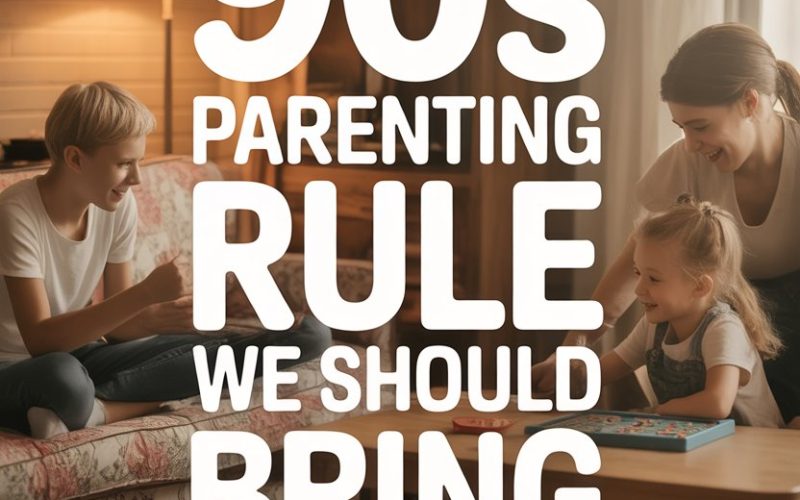You can spot a 90s kid from a mile away.
They’re the ones who let their kids eat grapes off the floor with a shrug, can recite every line from The Lion King without breaking eye contact, and sport a nostalgic glint when playground debates turn to “Who had the cooler Tamagotchi?”
But for all the neon windbreakers and dial-up woes, there’s one 90s parenting rule that deserves a comeback.
And no, it’s not making everyone gather around the cordless for family quiz night (though, tempting).
Hands-Off Parenting Wasn’t Neglect—It Was Trust
Back in the 90s, mum or dad wasn’t hovering at the end of every slide, poised to swoop in before a skinned knee could happen.
Instead, you’d hear, “Come home when the streetlights turn on!” If you were lucky, maybe a “Don’t forget your jacket!” tossed over the shoulder.
This wasn’t indifference. It was the art of letting go—on purpose. Parents set broad boundaries, showed kids the ropes, and then trusted them to try, fail, and try again.
It’s a style that experts like Dr. Peter Gray argue is crucial for developing independence and resilience.
Now, it would be an exaggeration to say 90s kids roamed the wilds, dodging mountain lions. Mostly, they dodged the neighbour’s hose and maybe the odd overzealous goose at the park.
The point: parents gave their kids room to breathe, make mistakes, and climb questionable trees.
Why We Drifted Away from Hands-Off Parenting
If you’ve ever found yourself checking your child’s location through three separate apps while standing outside the classroom gates, you’re not alone.
The pressure to supervise, orchestrate, and “enrich” every waking moment is real.
The rise of the “helicopter parent” is a modern phenomenon (yes, there’s an actual study on this), fuelled by social media, endless parenting books, and perhaps a pinch of collective anxiety.
Parents want their children to have every advantage, every safety net, and not a single scraped knee. Yet, the pendulum may have swung a bit too far.
Kids are busier and more “stimulated” than ever, but plenty of teachers and child psychologists whisper the same thing: Where’s their spark for adventure? Their problem-solving? Their sense of “I’ve got this”?
Freedom to Fail—And Why Kids Need It
Between the participation trophies and “everyone’s a winner” party bags, it’s easy to forget that failing—spectacularly, sometimes—is a rite of passage.
Back in the 90s, failure meant losing a footrace at lunch. Missing the ice cream van by thirty seconds. Being picked last for rounders.
And you got over it. Or you didn’t. Either way, Mum didn’t ring the school to demand an apology on your behalf.
Learning to dust yourself off is a muscle worth building. It’s resilience in action.
A 2017 University of Minnesota study found that children given more autonomy develop greater grit and adaptability—skills that come in handy long after primary school.
Unstructured Time Is a Superpower
Here’s a wild idea: boredom is good for children. There, I said it.
In the 90s, boredom was practically a weekend tradition. You’d stare at the ceiling, wander outside, invent elaborate games involving sticks, and then come home muddy and exhausted.
No one curated playdates like a wedding planner. Schedules had gaps—a luxury in itself.
Now, research by Dr. Teresa Belton suggests that boredom fuels creativity, curiosity, and problem-solving. Unstructured time allows children to figure out what they actually enjoy, not just what fills a calendar.
So, if your kiddo complains that there’s “nothing to do,” try not to panic. You’re raising a future inventor, not a cruise ship guest.
The Lost Art of Consequences
Back in the day, consequences were swift, obvious, and (usually) fair. Forgot your lunch? You got hungry. Broke your toy? You fixed it using enough sticky tape to immobilise a small animal.
Parents didn’t rush to solve every problem; they let reality teach, gently but firmly.
Natural consequences are sometimes the best teachers, especially for small slip-ups. There’s a temptation now to swoop in, solve, and pre-empt every mishap.
But as clinical psychologist Dr. Laura Markham points out, logical, compassionate consequences help children connect actions with outcomes—without shame or endless lectures.
No need to let your child wander into oncoming traffic (please don’t). But if they leave the Lego out and the dog eats it, well… lesson learned.
Kids in the Kitchen and Beyond
One of the unsung joys of 90s hands-off parenting: kids learned real-world skills early.
Not just how to make a sandwich, but actual “life admin.” You’d run errands, help with laundry, or—gasp—cook dinner for the family (yes, even with those terrifying spiral pasta gadgets).
Now, “age-appropriate responsibility” is the phrase du jour. But sometimes, we wait too long. Kids who help out feel capable and valued.
A 2015 Harvard study found that children who did chores grew into adults who were more independent and more successful in the workplace.
Toss your child the potato peeler, hand them a shopping list, let them fix their own snack. Sure, you might end up with a kitchen that looks like it’s been ransacked by raccoons—worth it for the confidence boost.
Screens and Self-Regulation
Technology itself wasn’t the enemy in the 90s. After all, who didn’t adore a bit of Super Mario?
The difference is, screen time was limited by the technology, not by a carefully calibrated timer app.
If your Game Boy batteries died, that was that. You got up and found something else to do (or spent an hour trying to revive the batteries in the fridge—no shame).
Encouraging self-regulation around screens is tricky now that devices are bottomless entertainment wells. But handing over the occasional reigns—within healthy boundaries—lets kids practice balance and develop their own off-switch.
Try setting up “screen-free” afternoons, then letting them fill the time however they wish. You might be surprised what they dream up when the WiFi is down.
Why This All Feels So Hard
A confession: it’s tough to embrace hands-off parenting when everyone else seems to be “enriching” their children at a fever pitch.
The pressure is real, especially when the group chat is abuzz with news of Little Chloe’s advanced Mandarin classes.
But here’s a friendly reminder—parenting isn’t a competitive sport, and it’s impossible to be everywhere at once. Your child doesn’t need a CEO-level itinerary; they need space to grow into themselves.
Sometimes, that means stepping back, arms folded, and letting them work it out.
And on rough days, when stepping back feels like the hardest thing in the world, there’s always a cup of tea. Or chocolate. Or both.
How to Bring Back the 90s Rule Tonight
Start with one small thing. Let your child make their own snack—even if the peanut butter ends up on the cat.
Hold back when a sibling squabble erupts and see if they sort it out themselves. Pause before offering solutions, and instead ask, “What do you think you should do?”
If your nerves start to tingle, remember: you’re not abandoning ship, you’re inviting your kids to steer (with training wheels firmly attached). The aim isn’t chaos—it’s confidence.
Give yourself permission to step aside and watch your child figure things out. They might surprise you.
And if nothing else, you’ll have more time to enjoy your tea while it’s still hot.
From One 90s Kid to Another
The world looks different now. There are more screens, more pressures, more expectations.
But children still need the same things: freedom to try, to fail, and to succeed on their own terms.
Dust off that hands-off 90s wisdom. Give your kids the gift of trust, a bit of boredom, and the space to learn who they are. It might just be the greatest parenting hack of all—no Tamagotchi required.





